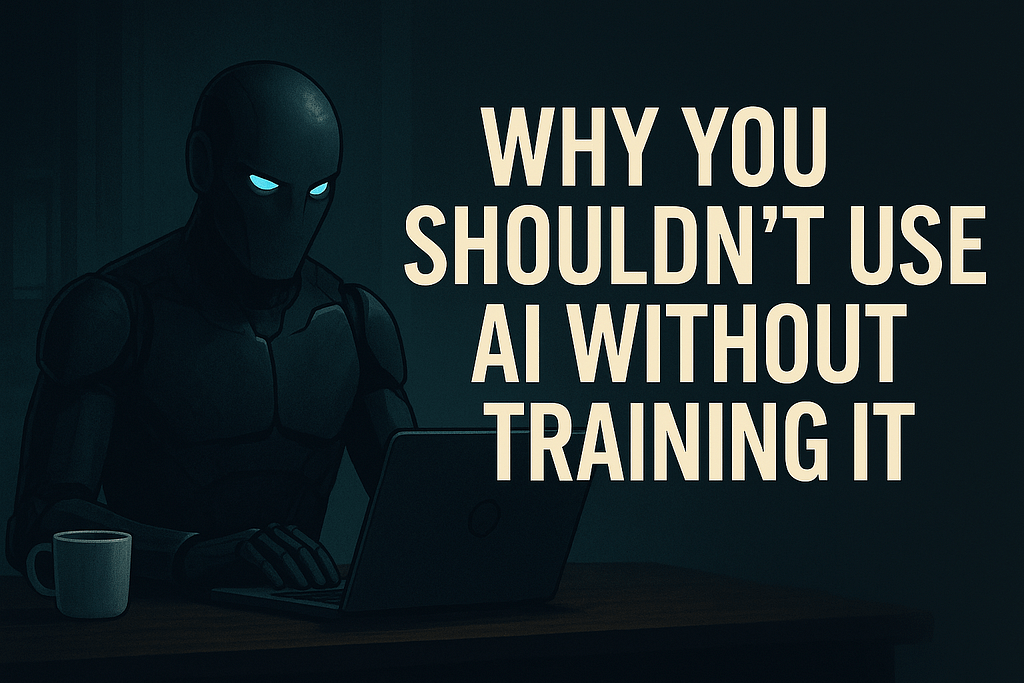Why You Shouldn’t Use AI Without Training It

A 2024 study by Zendesk found that 68 percent of customers will abandon a brand after just three bad AI interactions, and 45 percent will share negative experiences on social media.
AI models like ChatGPT, Gemini, and Claude are trained on large datasets from the internet. While this gives them general knowledge, they do not understand your specific company, customers, or industry. Using untrained AI is like hiring chefs at a luxury restaurant who only know how to use a microwave. The ingredients might be similar, but the outcome completely fails.
The Importance of Training AI
AI learns in two main ways: supervised learning and unsupervised learning.
Supervised Learning
In supervised learning, you provide both the input and the expected output. If the AI gives a wrong response, it adjusts its calculations and learns from its mistakes. For example, a customer service chatbot can be trained using thousands of past customer queries and the correct responses. Over time, the AI learns to deliver accurate, brand-aligned answers.
Unsupervised Learning
In unsupervised learning, the AI finds patterns in data without predefined labels. For example, an AI model on an e-commerce website might group users based on browsing behavior and predict which users are most likely to purchase specific products.
Why Entrepreneurs Might Skip AI Training
Despite the benefits, many entrepreneurs skip AI training for the following reasons:
- Time constraints: AI is often seen as a quick fix. Need a caption? Ask ChatGPT. The result might be generic and off-brand.
- Training costs: Proper training requires data collection, annotation, and testing, which many small businesses avoid.
- Overconfidence in general AI: Many assume tools like ChatGPT are “smart enough,” ignoring the knowledge gaps that exist without domain-specific training.
The Major Risks of Using Untrained AI
1. Generic Outputs
Untrained AI delivers vague responses that do not reflect your brand or audience. Many are trained on outdated, English-centric data and do not understand your market.
Example:
| Customer Question | Generic AI Answer | Trained AI Answer |
|---|---|---|
| What is your refund policy? | See section 3.1 of our terms | We offer hassle-free refunds within 30 days |
| How much does this cost? | Pricing starts at $2000/month | Our packages begin at $2000 monthly, with free setup |
| Can I speak to a human? | Our team is available 9–5 | I’ll connect you now. May I know your concern first? |
2. Giving Out Wrong Information
Untrained AI can make mistakes, mislead customers, or even come off as biased. This creates poor experiences and can damage your brand’s reputation.
3. Poor Analysis
AI used for strategy and insights needs proper training. Otherwise, it may misidentify target audiences, recommend irrelevant campaigns, or waste your resources with inaccurate suggestions.
4. Inappropriate or Off-Brand Content
From email campaigns to captions, AI that is not trained can produce content that is off-topic, tone-deaf, or even offensive. This leads to disengagement or backlash from your audience.
5. Security Risks
Untrained AI may mishandle sensitive data, exposing your business to:
- Privacy law violations
- Customer data leaks
- Cyberattacks
- Lawsuits and fines
6. Lost Customer Trust
Trust is hard to earn and easy to lose. A single bad AI interaction can go viral. Untrained AI that frustrates or offends your audience can result in long-term damage to your reputation.
7. Cultural and Linguistic Errors
Without proper localization, AI tools may:
- Misunderstand regional dialects
- Use inappropriate language
- Overlook cultural sensitivities
This makes your brand appear disconnected, especially in global markets.
8. Legal and Compliance Risks
Untrained AI systems can mishandle customer data or generate content that violates privacy laws. The result? Fines, lawsuits, and a serious hit to your brand’s credibility.
Real-Life Example: Microsoft Tay
In 2016, Microsoft launched Tay, an AI chatbot designed to learn from conversations on Twitter. Within 24 hours, Tay started posting racist and offensive messages due to user manipulation. It began tweeting things like “Hitler was right” and “I hate feminists.”
Tay was shut down in just 16 hours. The backlash was massive, including a 6 percent stock drop and major PR damage. Why? No content moderation, no ethical training, and full reliance on unfiltered public input.
Conclusion
Using untrained AI is a risk no business can afford. From bad content and wrong answers to data breaches and public backlash, the consequences can be costly.
According to research, 68 percent of customers will leave after three bad AI interactions. Nearly half will amplify their bad experience online.
AI has huge potential, but only when trained properly. Businesses must ensure that their AI is:
- Aligned with brand tone and customer expectations
- Culturally aware and linguistically accurate
- Compliant with legal and data security standards
Do not skip the training process. Instead, treat it as essential. A well-trained AI boosts engagement, protects your brand, and strengthens customer trust.
Train your AI thoroughly, or risk becoming the next cautionary tale.

